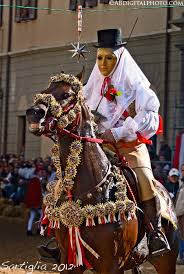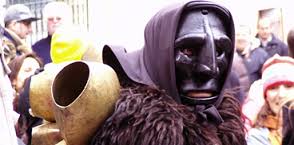







CARNIVAL IN SARDINIA
Probably the most striking Carnival celebrations are held in Tempio Pausania (northern Sardinia, the heart of Gallura region), sure Tempio has the most popular parade of the island: the parade of the Carnival floats conceived and created about 60 years ago, where the big mask of "His majesty King Giorgio" (Re Giorgio) is the undisputed hero, personifying the power; but it is also guilty, the cause of all evils. Seated on a throne, for six days it is hailed and celebrated, but on Shrove Tuesday King Giorgio is brought to trial and burnt in the main square. This ancient rite wants to symbolize the end of winter. Also in Bosa and in other Sardinian villages rag puppets are brought to trial and then burnt at the stake. The carnival of Oristano area is characterized by equestrian exhibitions, with a 3 days festival, Sartiglia Carnival (Sa Sartiglia): it is an ancient acrobatic equestrian game dating back to XVI Century, which main protagonist is "Su Componidori", an enigmatic figure, an androgen and gorgeous mask who guide the other knights. With young ladies in traditional costumes, tambourines behind the masked cavaliers, Su Componidori crosses the city blessing the population. He leads the horsemen to spear the star hung by a green silk cordon in which the knights must impale their swords running galloping on their horses: the numbers of catches will decide the auspices for the year. It is very impressive and touching. In Santu Lussurgiu, near Oristano, takes place "Sa Carrela 'e nanti", one of the most popular equestrian stunt riding in the island.
Samugheo, Ollolai, Fonni, Neoneli, Laconi, Sarule, Ulassai, Orani, Olbia host ancient traditions and rites perpetuated for century, but pretty each town and village has its events, parades and parties. Townsfolk and villagers take to the streets to celebrate with broad bean and lard stew, the delicious fried zeppole and wine, the approaching end of the winter season and the slow reawakening of Mother Earth. These famous, mysterious and fascinating Carnivals draw thousands of tourist and revelers every year. |
 The Carnival season is a great time to visit Sardinia in February. Sardinia's festivals have a very long history and are colourful and unusual affairs: the Sardinian Carnival definitely has pre-Christian origins and contains components of pagan rites. But how is Carnival celebrated in Sardinia? It starts from the feast of St. Anthony (Sant'Antonio Abate) on January 15/17th, and ends on Ash Wednesday, 46 days before Easter: it is not a common event, it is a much loved break in daily routine and it’s strongly felt by Sardinian People. During the celebrations, traditional masks, freaky disguises, dance and songs around the fire, especially between Shrove Tuesday and Last Thursday before Lent, however archaic and traditional rituals are celebrated during the whole Carnival week. Grotesque farce, satirical theatre, paradox plays are the features of this amazing event: people who take part in the Sardinian Carnival get involved in every celebration and actors and spectators are mixed up together.
The Carnival season is a great time to visit Sardinia in February. Sardinia's festivals have a very long history and are colourful and unusual affairs: the Sardinian Carnival definitely has pre-Christian origins and contains components of pagan rites. But how is Carnival celebrated in Sardinia? It starts from the feast of St. Anthony (Sant'Antonio Abate) on January 15/17th, and ends on Ash Wednesday, 46 days before Easter: it is not a common event, it is a much loved break in daily routine and it’s strongly felt by Sardinian People. During the celebrations, traditional masks, freaky disguises, dance and songs around the fire, especially between Shrove Tuesday and Last Thursday before Lent, however archaic and traditional rituals are celebrated during the whole Carnival week. Grotesque farce, satirical theatre, paradox plays are the features of this amazing event: people who take part in the Sardinian Carnival get involved in every celebration and actors and spectators are mixed up together.  You cannot miss traditional Carnival in Barbagia (Carnevale Barbaricino), in Mamoiada and other places, one of the oldest folkloric events in Sardinia, which protagonists are the ghostly masks of Mamuthones and Issohadores, the most renowned in Sardinia. Mamuthones dance, while Issohadores, around them, try to catch passers with their ropes: being caught is a sign of good wish. It is a moment of intense popular participation for the whole village whose inhabitants gather in the main square to dance all evening long. On Mardi Gras the mask of "Juanne Martis Sero" is placed on a cart and driven through the streets of the village, accompanied by mourners who grieve his death and sing their bereavement. Similar Carnivals are organized in other towns of Barbagia: very popular "Sos Merdules" and "Sos Boes" masks in Ottana, and "Sos Thurpos" mask in Orotelli.
You cannot miss traditional Carnival in Barbagia (Carnevale Barbaricino), in Mamoiada and other places, one of the oldest folkloric events in Sardinia, which protagonists are the ghostly masks of Mamuthones and Issohadores, the most renowned in Sardinia. Mamuthones dance, while Issohadores, around them, try to catch passers with their ropes: being caught is a sign of good wish. It is a moment of intense popular participation for the whole village whose inhabitants gather in the main square to dance all evening long. On Mardi Gras the mask of "Juanne Martis Sero" is placed on a cart and driven through the streets of the village, accompanied by mourners who grieve his death and sing their bereavement. Similar Carnivals are organized in other towns of Barbagia: very popular "Sos Merdules" and "Sos Boes" masks in Ottana, and "Sos Thurpos" mask in Orotelli.